iCloud gives you instant access to files and apps you need across all your devices. It has 5 GB of space that you can use for free and additional storage is relatively inexpensive, so if you have multiple Apple devices, it’s definitely the most convenient way of file management. But this space is finite, so running into the “iCloud Storage Almost Full” or “Not Enough Storage” messages is inevitable. Here’s how to deal with them.
Why is my iCloud storage full?
A default account only has 5 GB of free storage space. It is hardly enough even for backups, though it may be sufficient for syncing contacts and notes. If you sync photos, files, and videos to iCloud Drive and use iCloud to back up devices, the storage will become full pretty fast, even if you have upgraded to 50 or 200 GB.
Another reason for iCloud storage getting full is enabling the Optimize Mac Storage feature. It moves files to the cloud and deletes them from local storage. While helping you reclaim space on MacBook, it creates another issue. But luckily, you can do a lot to free up iCloud storage.
How to check iCloud storage
Before removing unneeded files, let’s start with the basics — checking iCloud storage. The steps vary a bit depending on which device you use.
Mac
Go to System Settings > Apple Account > iCloud.

iPhone & iPad
- Open Settings.
- Tap Apple Account > iCloud.
- Wait for the Storage graph to load.
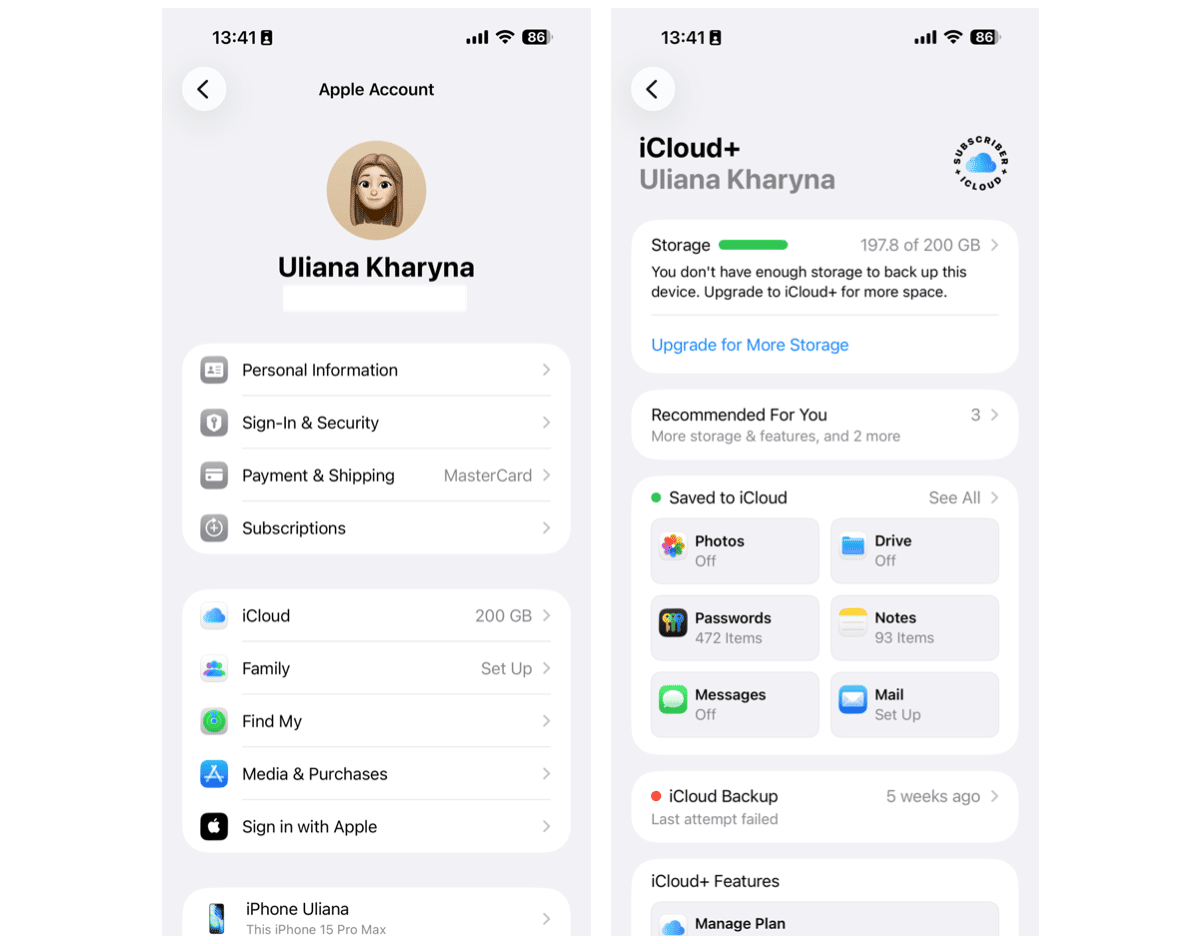
How to clear iCloud storage
If you sync both your iPhone and Mac data to iCloud, eventually, storage will fill up again unless you learn how to use it more wisely. So, we’ll go over a few steps you can take to quickly free up iCloud storage now and regularly clean up your iCloud in the future.
Step 1. Clean up junk files on Mac and remove iCloud clutter more efficiently
If you use iCloud to sync your iPhone and Mac, your Mac may be quietly filling up your cloud storage without you realizing it. Cache files, outdated documents, app leftovers, and system junk can all be synced to iCloud, piling up over time.
You could try removing these manually, but it’s risky and time-consuming. A better option is to use a tool like CleanMyMac, which helps you safely clear out clutter and now includes a feature to manage your cloud accounts more effectively.
Here's how to use it:
- Start your free CleanMyMac trial.
- First, click Cleanup to scan your Mac for unneeded junk files. Review and remove the unneeded items.
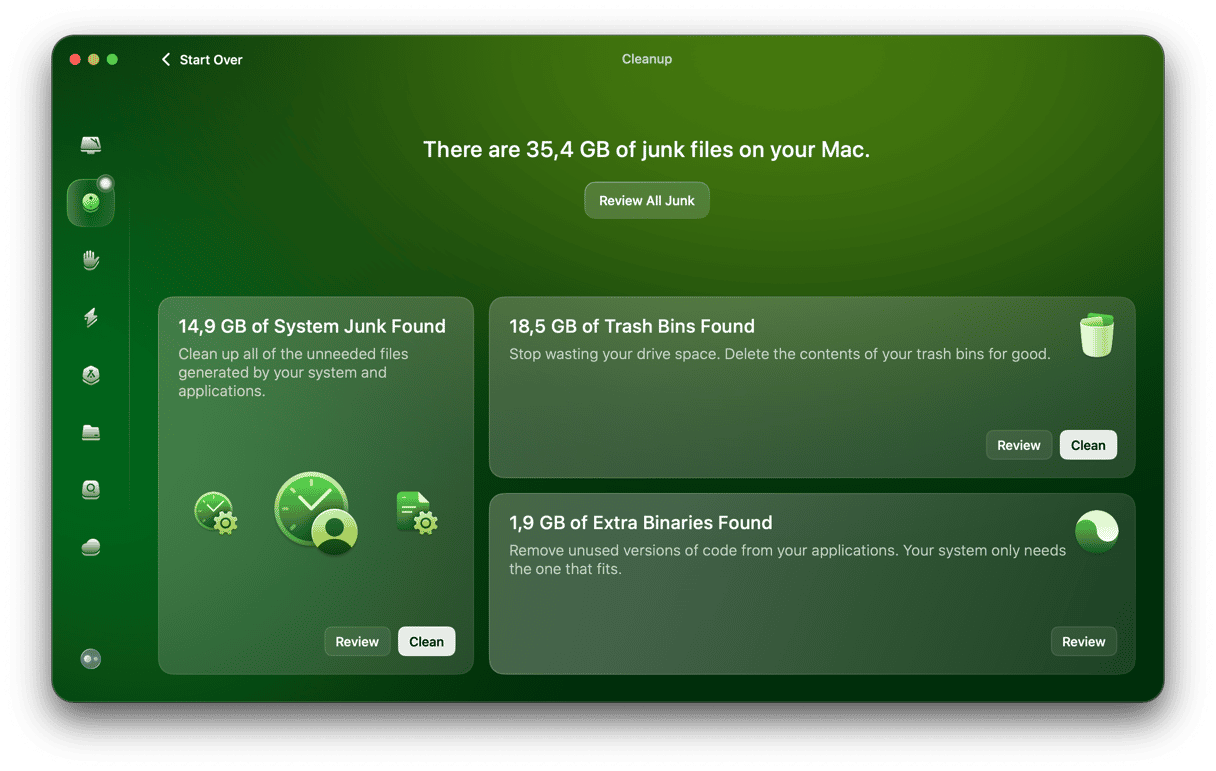
- Then, switch to Cloud Cleanup to connect your iCloud and other cloud storage accounts.
- Once synced, you’ll see which files are stored locally and in the cloud. You can review and remove the ones you no longer need with just a few clicks.
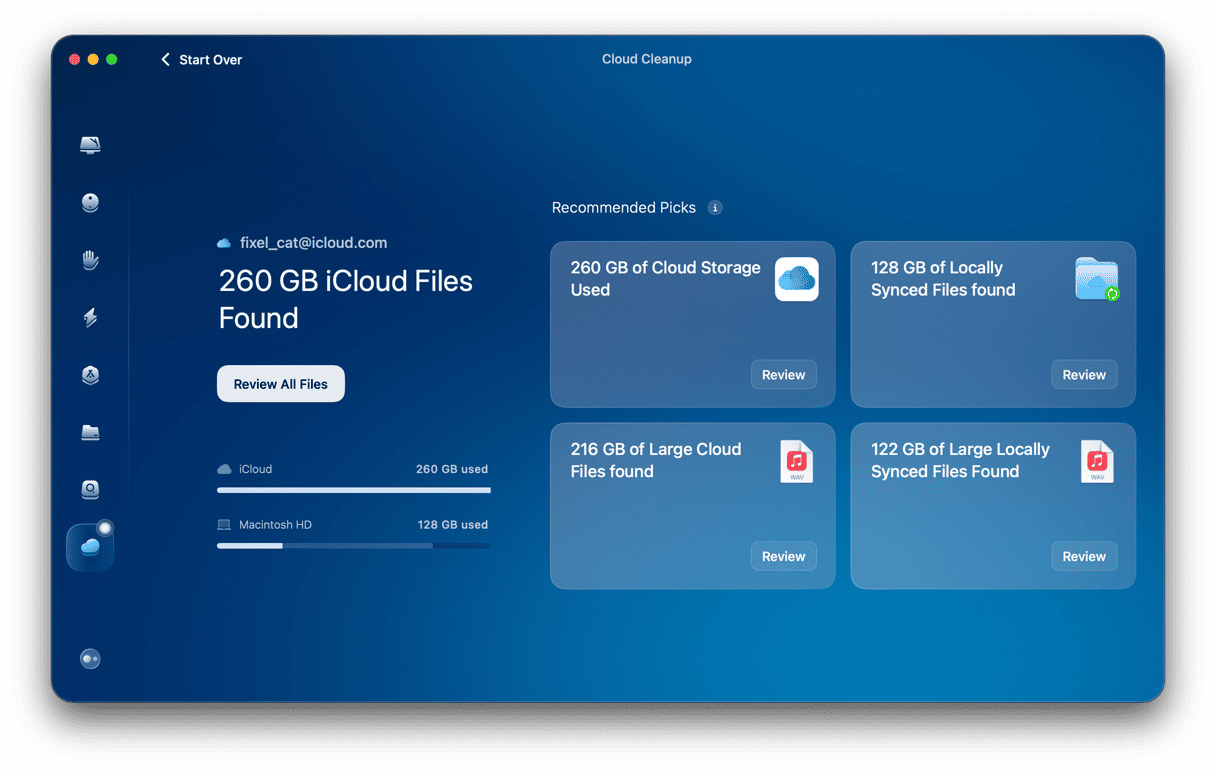
This gives you a clear view of what’s really using up your iCloud space — not just on your iPhone, but across all your devices.
Step 2. Delete old files in your iCloud
Since macOS Sierra, the system automatically stashes old files — like movies you’ve already watched — to iCloud, which helps you save storage on your Mac. But the problem is that these files still occupy space, except now it’s the precious space in your iCloud. To see what you’ve got there and what you can delete, do the following:
- Sign in to your account at icloud.com.
- Click Drive.
- Go through your files and select the ones you no longer need.
- Click the ellipsis and choose Delete Selected. Do not forget to empty the Recently Deleted folder by clicking Delete All.
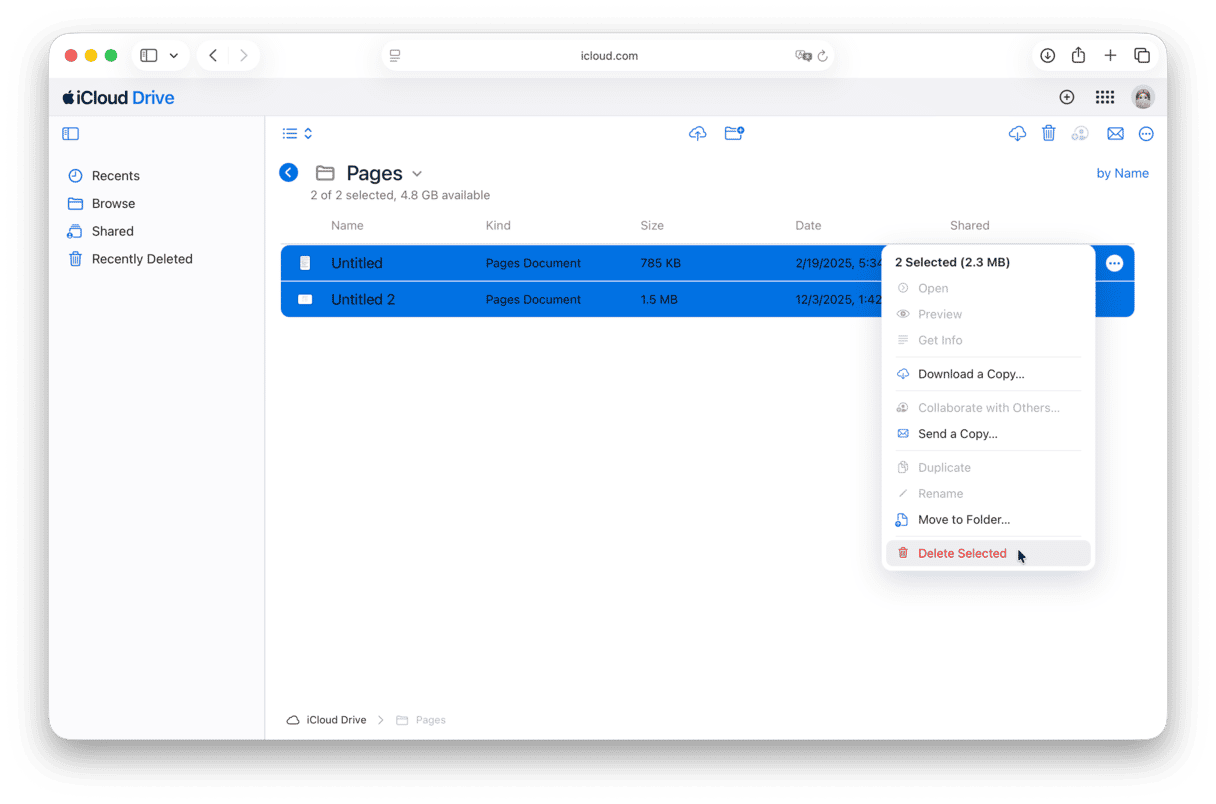
Done. If you’re using macOS High Sierra or later, iCloud Drive is also available as a folder in the Finder, so you can do the same on your Mac.
Step 3. Delete iCloud emails you don’t need
If you’re using an iCloud email account (the one that ends with @icloud.com), all email messages you get are stored in — you guessed it — iCloud. And while emails themselves don’t weigh that much, email attachments do. PDFs, photos, and other files people have sent to you over the months can add up to a few gigabytes, so go over your old correspondence and do some spring cleaning.
- Once again, log into your account at icloud.com.
- Click Mail.
- Check your Inbox and delete anything you do not need. Right-click an email and choose Trash Message.

- Do the same for Sent and Archive.
- Now, go to Trash, press Command + A, and click Delete. Alternatively, right-click any email and choose Delete [x] Messages.
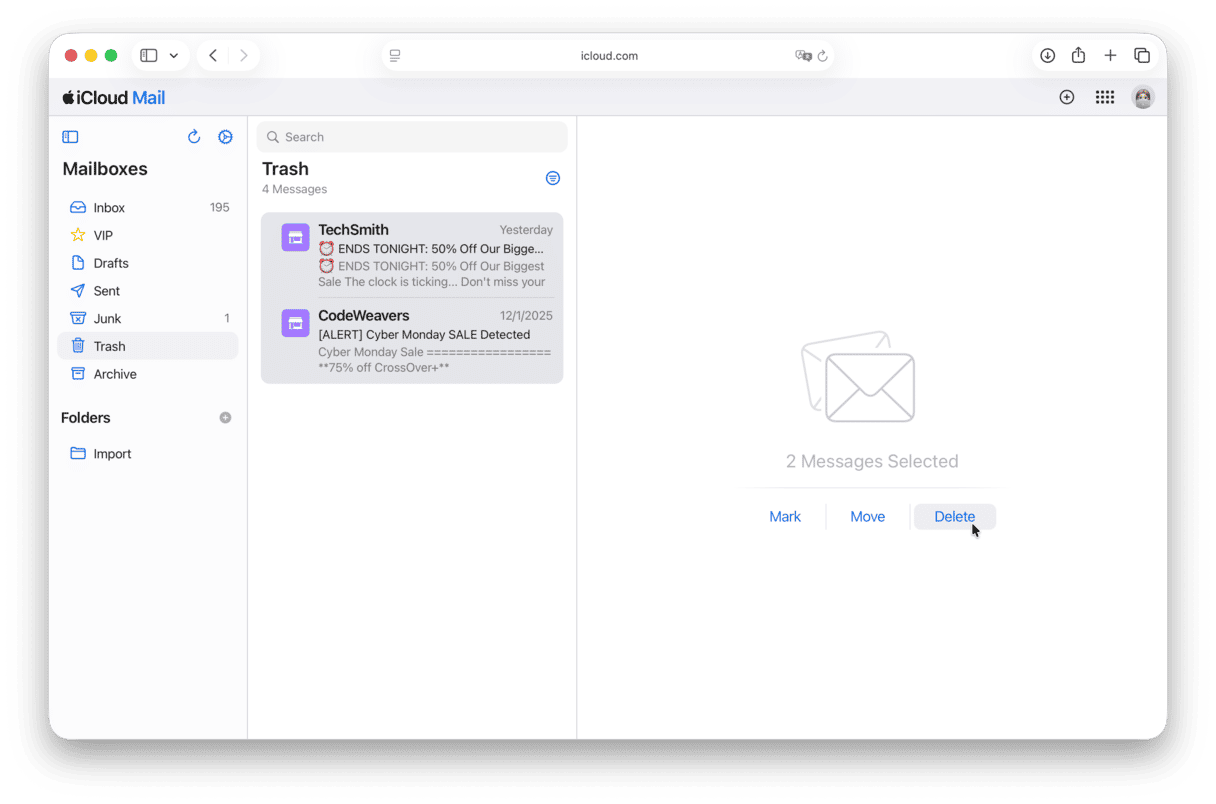
It’s a good idea to develop the habit of trashing any email you know you won’t need in the future right away to avoid space-hogging in the first place.
Step 4. Delete outdated backups
Having iCloud automatically back up your iPhone on a regular basis is a great way to keep your data intact in case something happens to the phone. But the only backup you’re going to need in this case is the most recent one, so there’s no reason to store backups made months ago.
This is how you access all your device backups and delete outdated ones:
- On your Mac, go to System Settings > Apple Account > iCloud.
- Click Manage and then Backups.
- Select a backup you want to remove and then click Delete (“-” button).
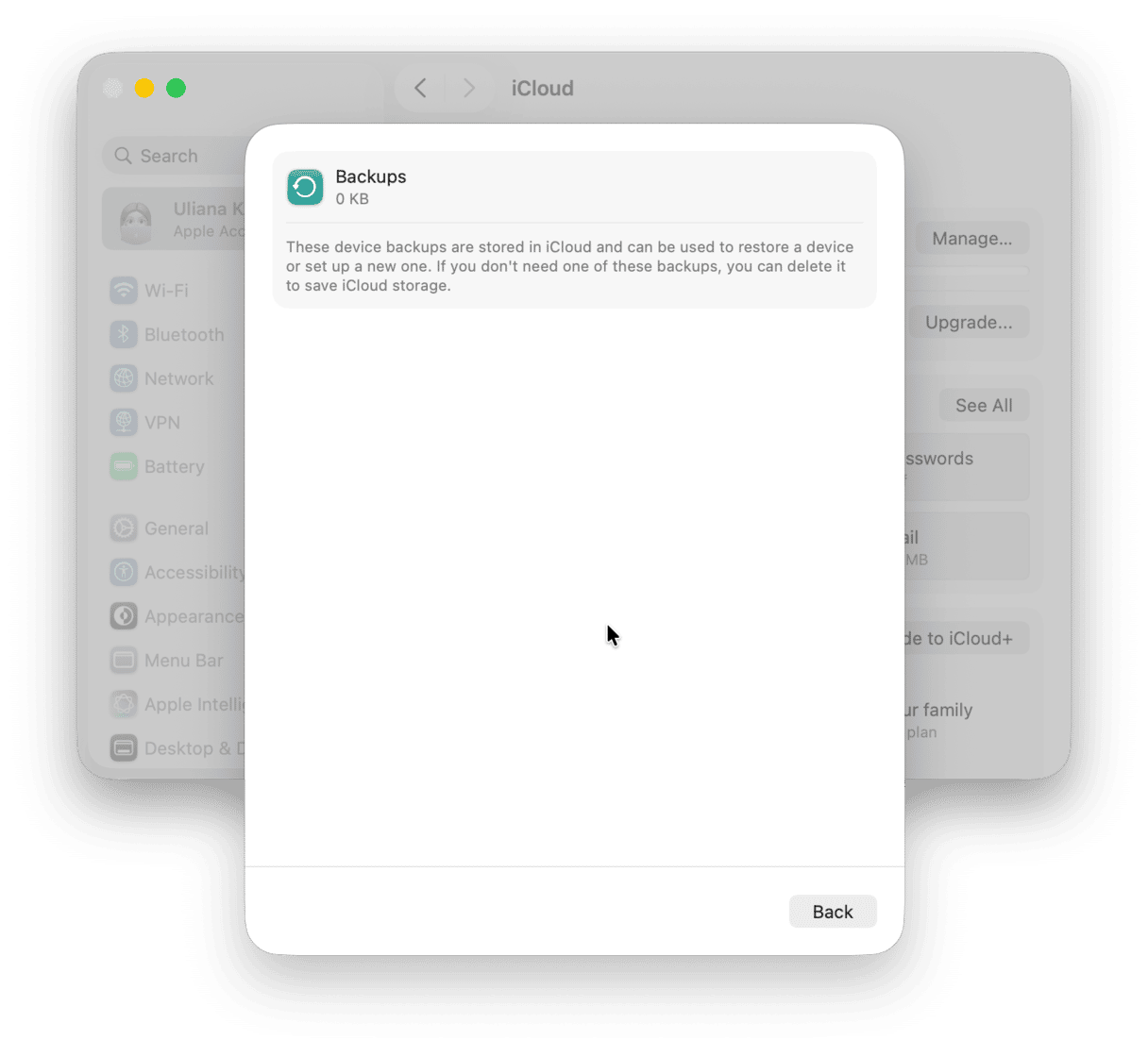
It’s important to know that when you delete a backup, it switches off the backup feature for this device.
Step 5. Delete messages and email attachments from iCloud
Old messages and attachments also take up a lot of space, so it’s better to delete them. How to delete messages from iCloud? Like with all of the steps above, there are different ways for iPhone and Mac. We’ll start with removing email attachments on Mac and then switch to deleting old messages and message attachments on both Mac and iPhone.
In the Mail app on your Mac:
- Open Mail.
- Select one or several messages. You can also press Command + A to select all messages.
- Click Message > Remove Attachment(s). Repeat for all mailboxes.

Now, let’s proceed with messages. On your Mac:
- Open the Messages app.
- Right-click the conversation you want to delete and choose Delete. Confirm the deletion.
- Now, click View > Recently Deleted and delete unneeded conversations once and for all.
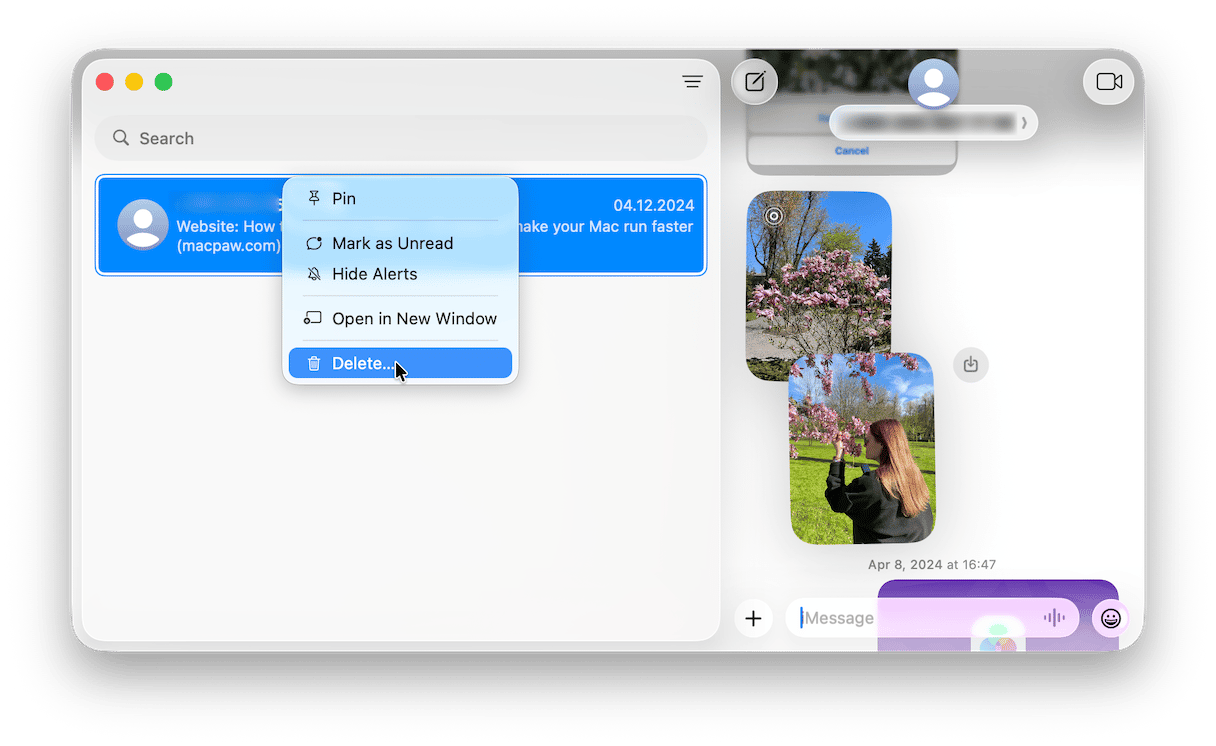
If you don’t want to delete the conversation but just get rid of attachments, open the dialogue and click i. Under Photos, select what you want to remove, right-click, and choose Delete > Delete Attachment(s). Note that it cannot be restored.
On your iPhone/iPad:
- Open Messages.
- Tap Edit > Select Messages.
- Select Messages you don’t need and tap Delete.
- Confirm deletion.
- Now, tap Edit > Recently Deleted > Delete All > Delete [x] Messages.
The next step is to delete message attachments on iPhone. Note, though, that they will be deleted from Messages and cannot be restored, so take this step with caution.
- Open Settings > General > iPhone Storage.
- Scroll to Messages.
- Tap Photos > Edit and select what to remove.
- Tap the Trash icon on the top right.
- Do the same for GIFs and Stickers.
Alternatively, you can open Messages, select a conversation with attachments, and tap the contact bubble at the top. Now, tap See All next to Photos and press Select > Delete > Delete Attachment.
Step 6. Empty all trashes
It’s easy to forget that as long as files remain in the Trash (or in the Recently Deleted folder if we’re talking about photos), they still occupy space, be it in the cloud or locally. So, after you’re done with steps 1-5, be sure to take out the trash.
In the Photos app on your Mac:
- Open Photos.
- Go to Recently Deleted.
- Click Delete All > Delete From All Devices.
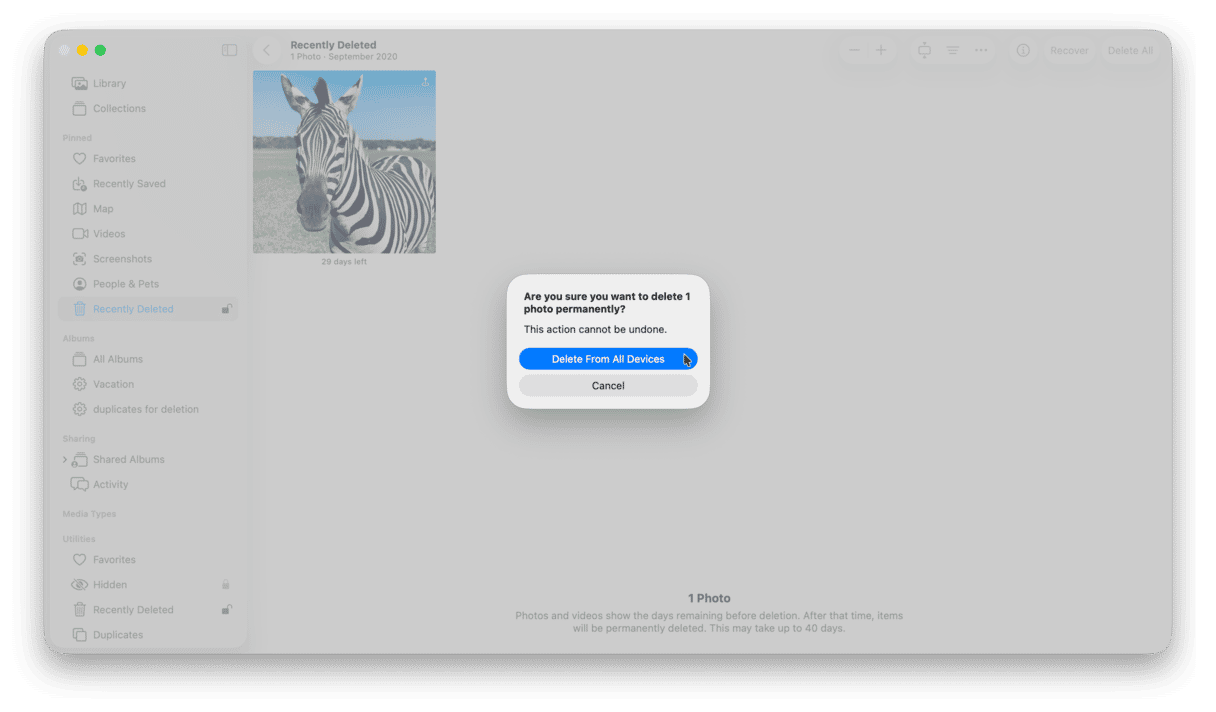
In the Mail app on your Mac:
- Open Mail.
- Click Mailbox in the top menu.
- Choose Erase Deleted Items from the dropdown menu.
- Select your iCloud email address and click Erase.
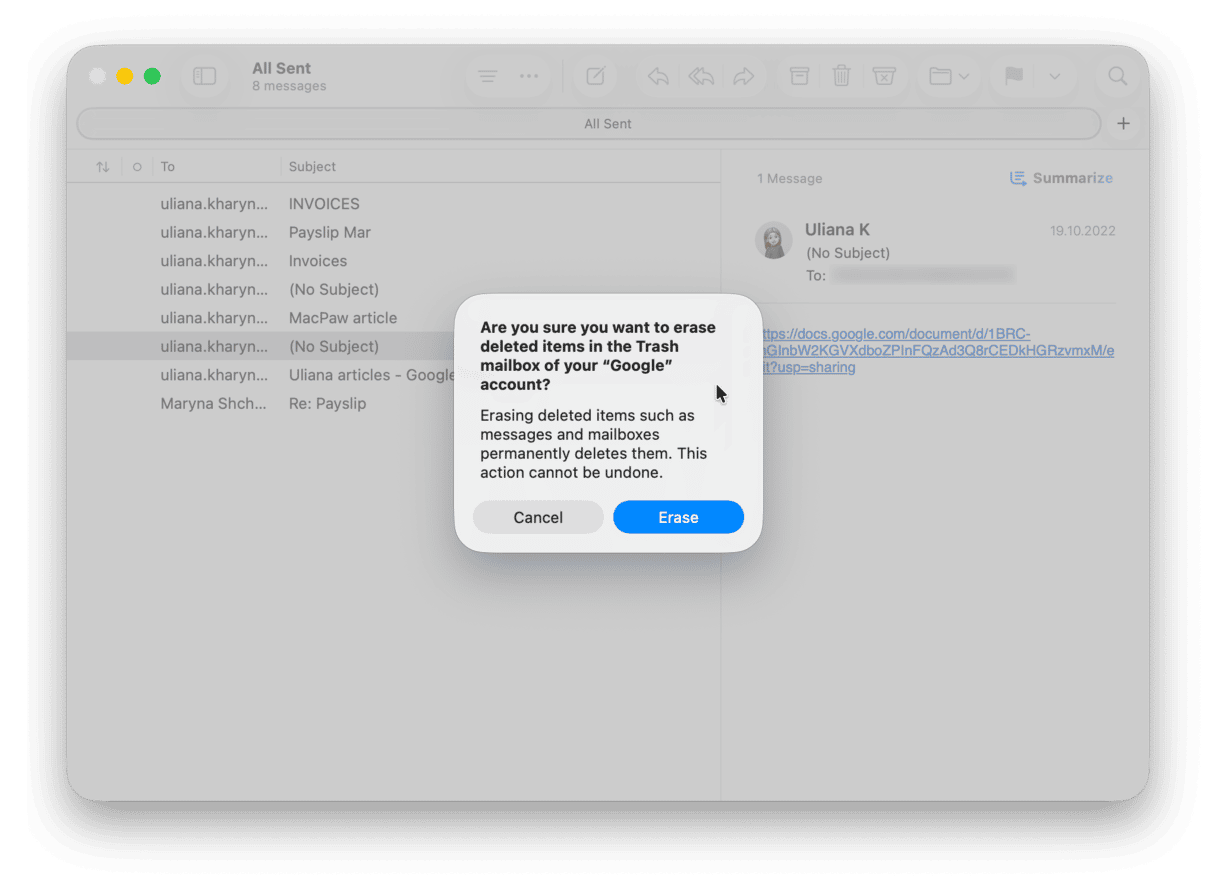
In the Photos app on your iPhone/iPad:
- Open Photos.
- Go to Collections > Recently Deleted.
- Tap Select > Ellipsis.
- Now, tap Delete All > Delete From This iPhone.
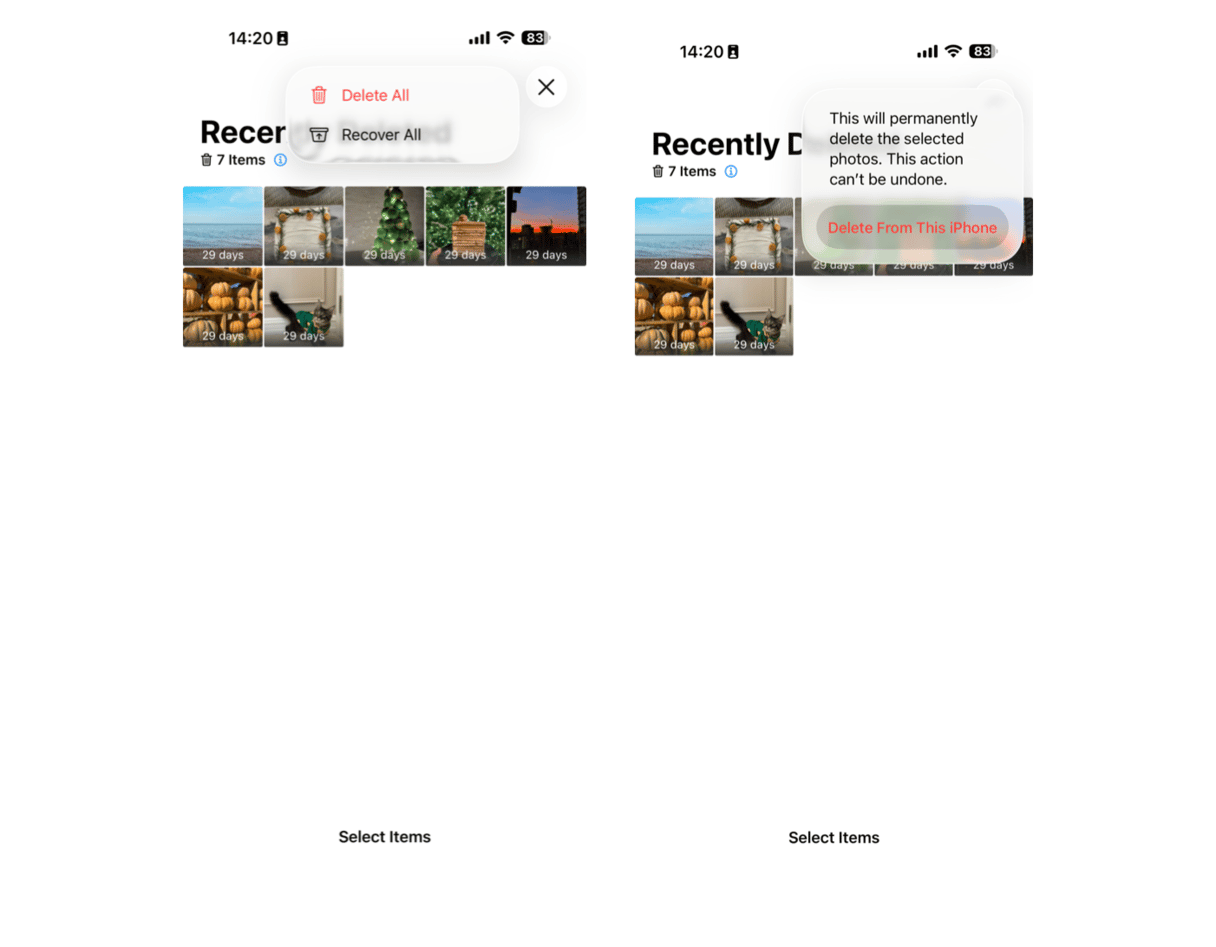
In the Mail app on your iPhone:
- Open the app.
- Tap Trash (Bin).
- Tap Edit
- Select All and then Delete All.
That’s it. This should help you get more iCloud storage, at least for now. Go over these steps every 1-2 weeks to make sure your iCloud doesn’t get clogged up again.
Step 7. Declutter your iPhone to free up iCloud storage
With iCloud Photo Library enabled on your iPhone, every photo you take gets automatically synced to the cloud. Each individual photo doesn’t take much space, but if you take 3-4 shots every time until you get the one you like, those megabytes quickly add up. So, how to delete stuff from iCloud?
One way to deal with it is to rummage through your library and clean out these unneeded photos manually. A faster way is to download CleanMy®Phone. This iPhone app streamlines the process by finding and preselecting similar photos, largest videos, low-quality shots, and screenshots, so you just need to tap Delete.
With iCloud Photo Library turned on, the photos you delete on your iPhone will also be removed from the cloud, so you’ll easily free up some iCloud space. The app is free to download, so go ahead and try it on your iPhone.
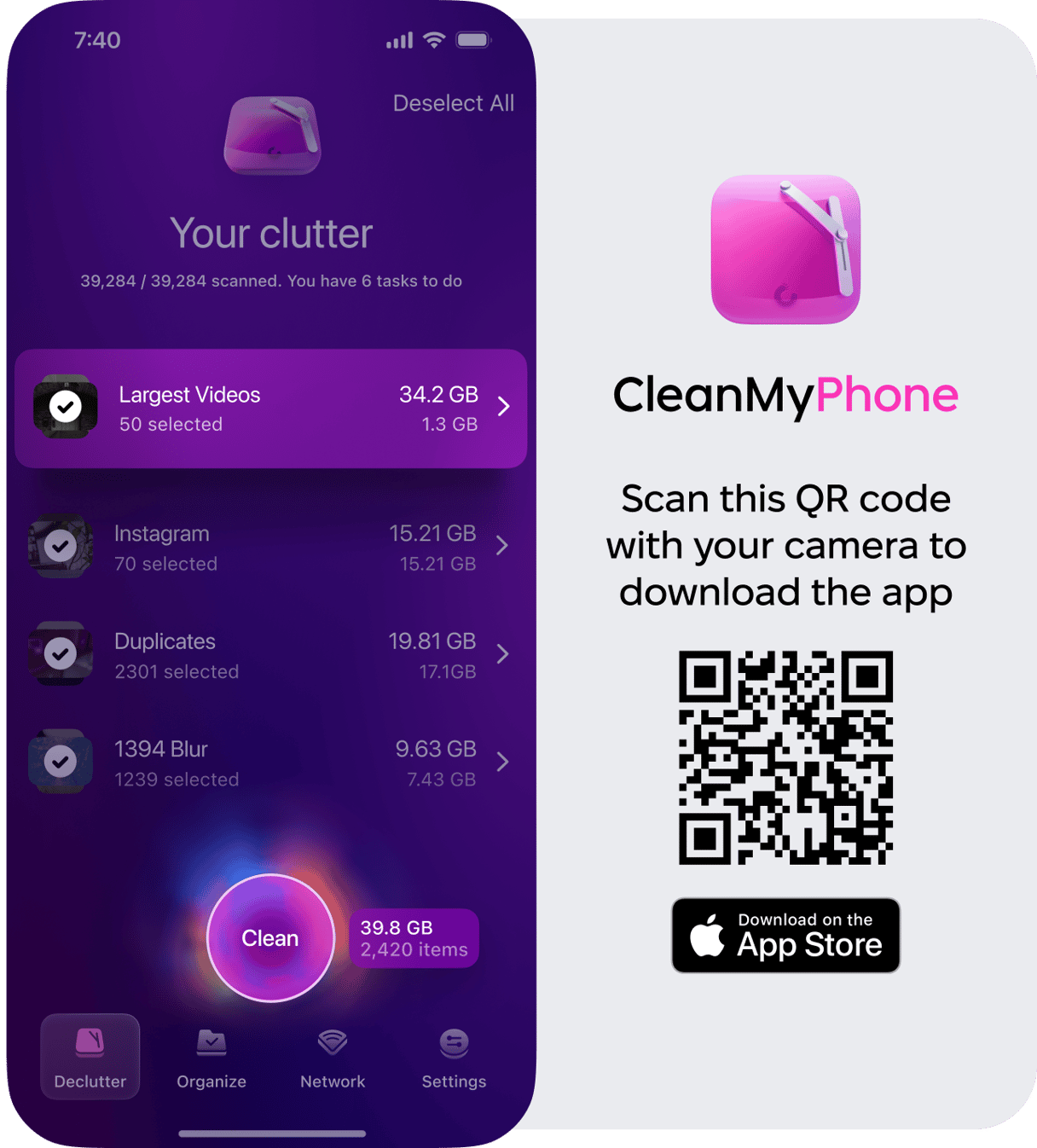
As an added bonus, it will be much easier and faster to download your photos from iCloud should you ever decide to stop using it. When your photo library isn’t bloated because of useless duplicates and old screenshots, it becomes much easier to move to and from cloud storage.
How to manage iCloud storage on Mac and iPhone/iPad
This is an obvious way out if you’re not too short on budget and don’t mind spending money on storage every month.
So, how do you upgrade iCloud storage? Getting more space is easy, and you can do it from any device, including your iPhone. Keep in mind, managing iCloud storage goes both ways. You can either upgrade or downgrade it. Let's take a look at both options starting from the former.
How to buy iCloud storage
On your Mac, go to Settings > Apple Account > iCloud > Manage > Change Storage Plan.
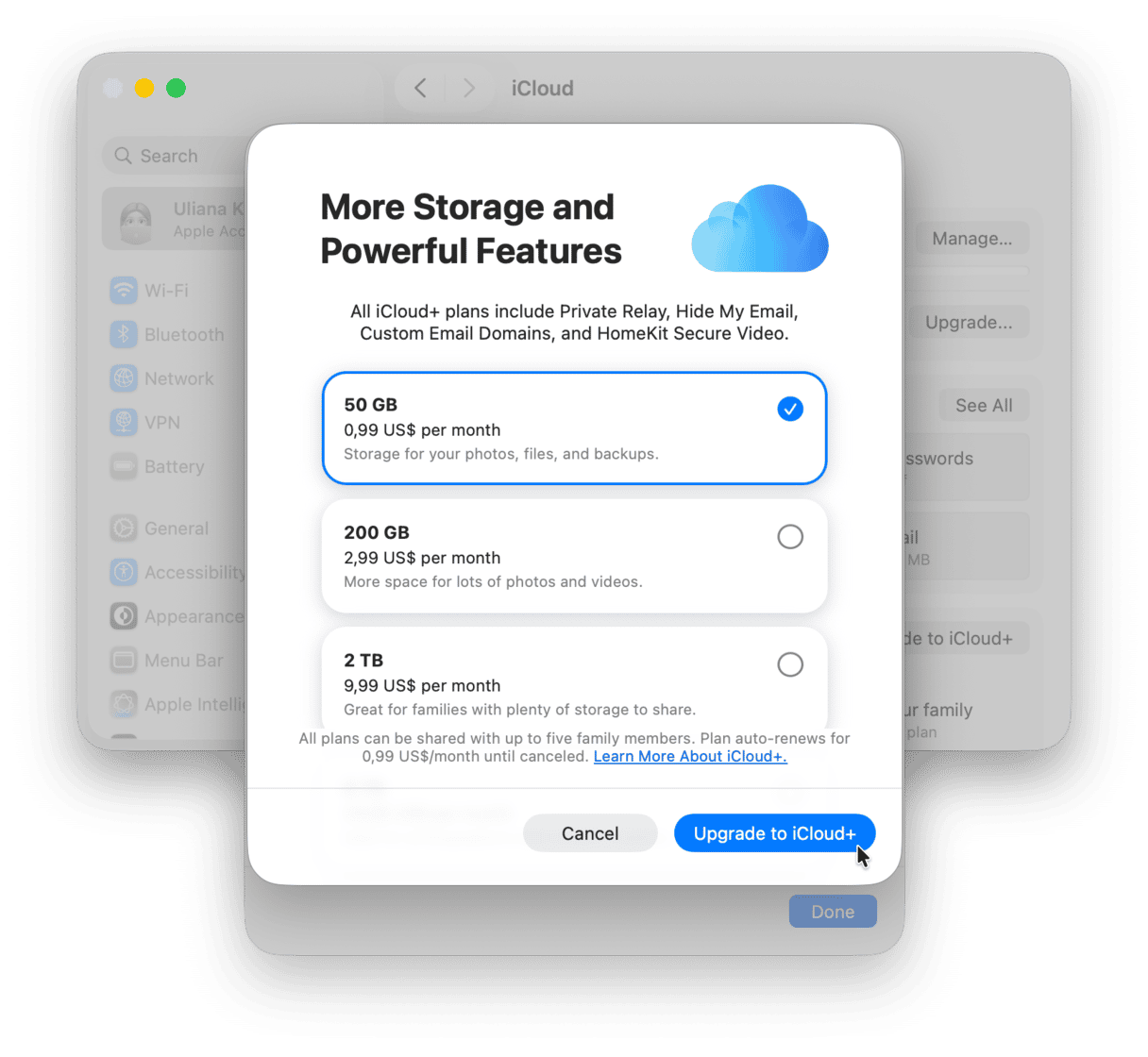
On iPhone/iPad, it’s almost the same, only from Settings > Apple Account> iCloud, you’re going to Storage > Change Storage Plan.
Upgrading your storage plan is straightforward and takes just a few minutes. Once you complete the upgrade, your additional storage becomes available immediately. In addition to extra storage, you also get some premium features, including iCloud Private Relay, Hide My Email, and support for HomeKit Secure Video as well as the ability to share your plan with family members and have a custom email domain. All these make up iCloud+.
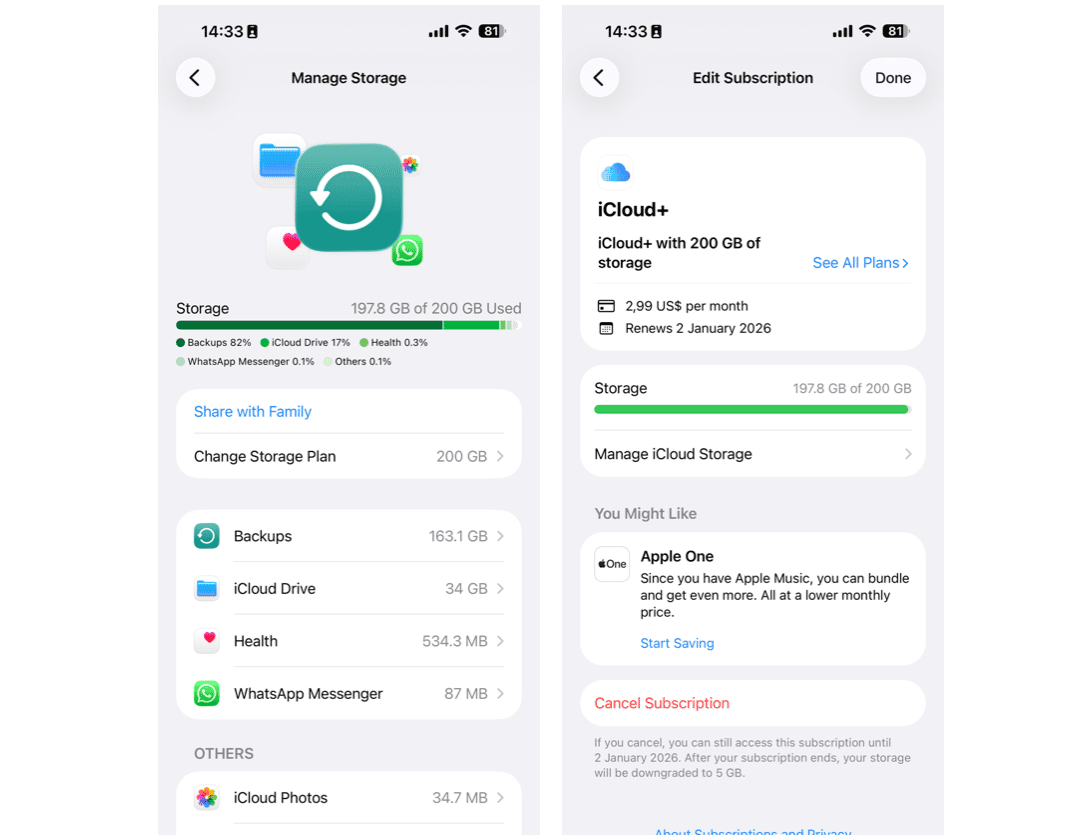
Apple offers different storage plans to fit various needs, and you can change or cancel your plan anytime. Make sure to keep your payment method up to date to avoid any interruptions in your iCloud service.
The next logical question you have is how much iCloud storage costs. Well, that depends primarily on your location and how much storage you’d like to get. There are plans for 50 GB or 200 GB and even up to 12 TB. The exact cost is stated right in the menu when you open it, next to the plan.
If you decide to downgrade your iCloud storage plan, follow the same steps as above, but choose a lower-tier storage plan.
How to delete stuff from iCloud
For the most part, the answer to questions like how to delete data from iCloud storage, any data, is more than simple — just open the iCloud Drive folder and delete files from it. You can sort by size here (just choose the List view).
That’s it — these files will no longer show on other devices. To delete files, simply move the icon to the Trash or choose the file and press Command(⌘)-Delete.
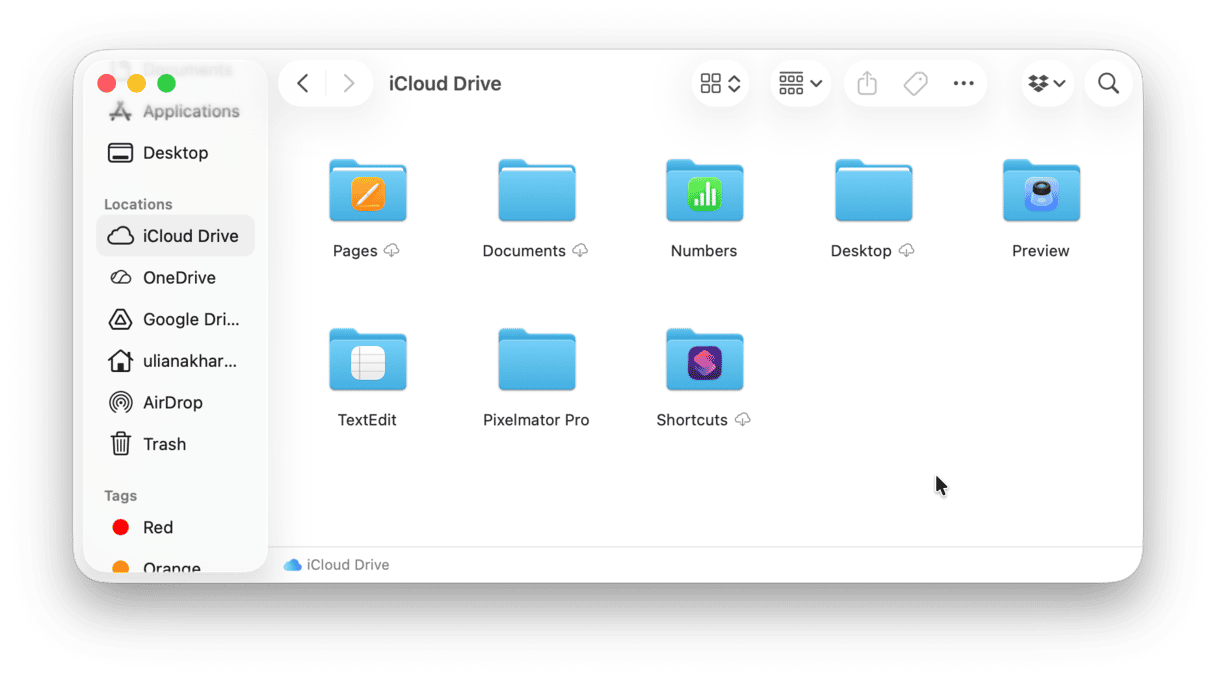
Unsync the Desktop & Documents folders
The Desktop & Documents folders are usually the graveyards of forgotten files. If left unwatched, they can quickly eat up the iCloud storage space. So, if you do not clean them up regularly, it is better to disable syncing these folders.
- Go to System Settings > Apple Account > iCloud > Drive.
- Turn off Desktop & Documents Folders.
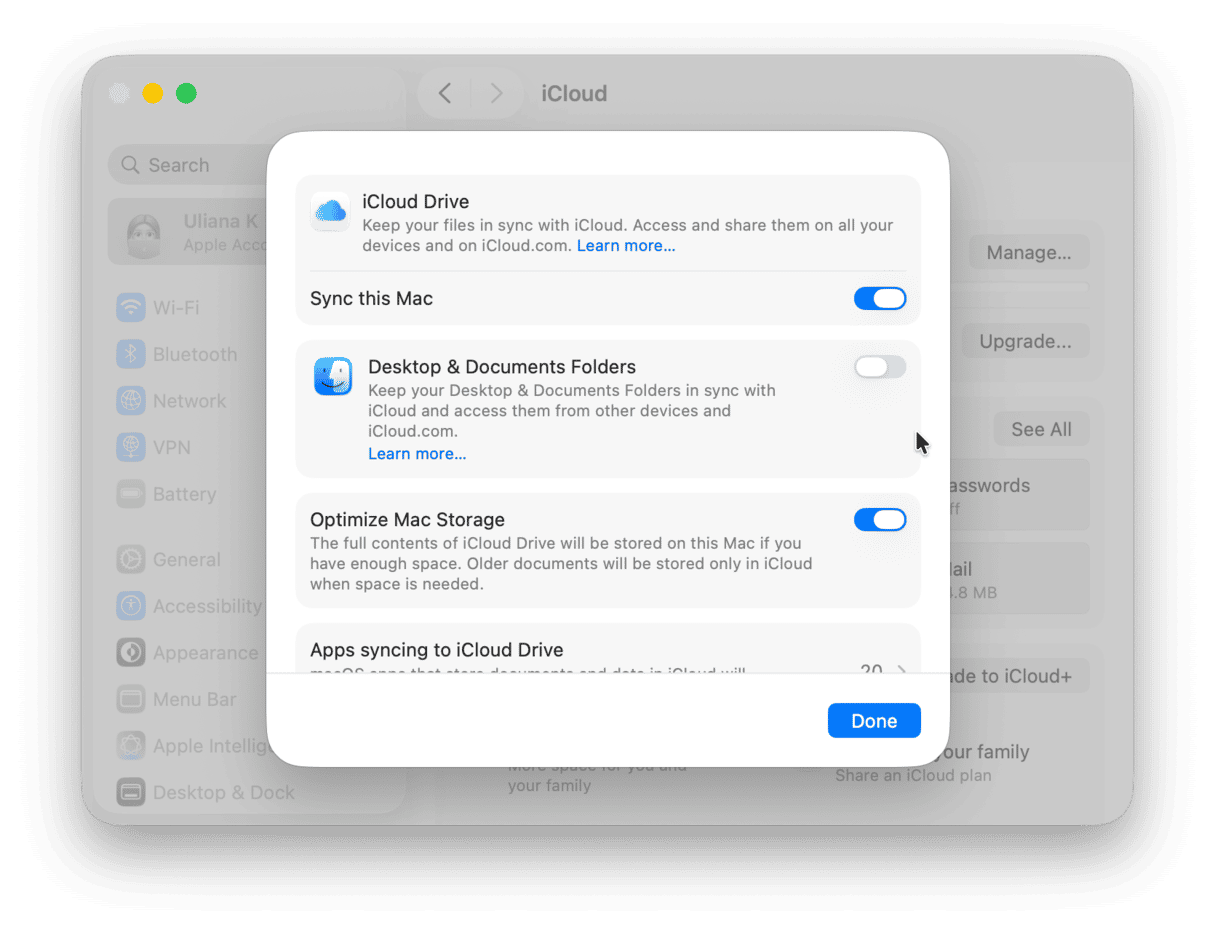
How to delete photos from iCloud
As you might have guessed, there are actually different scenarios for photos stored in your libraries and streams. Deleting specific photos from iCloud can be performed in two simple ways:
- Delete images directly from the Photos app itself. Open the app, choose the images to delete, press Command(⌘)-Delete, and with the next sync, they will be gone from your iCloud.
- Delete them from the iCloud website. To do it, sign in to icloud.com, go to Photos, find the images you no longer need, and delete them.
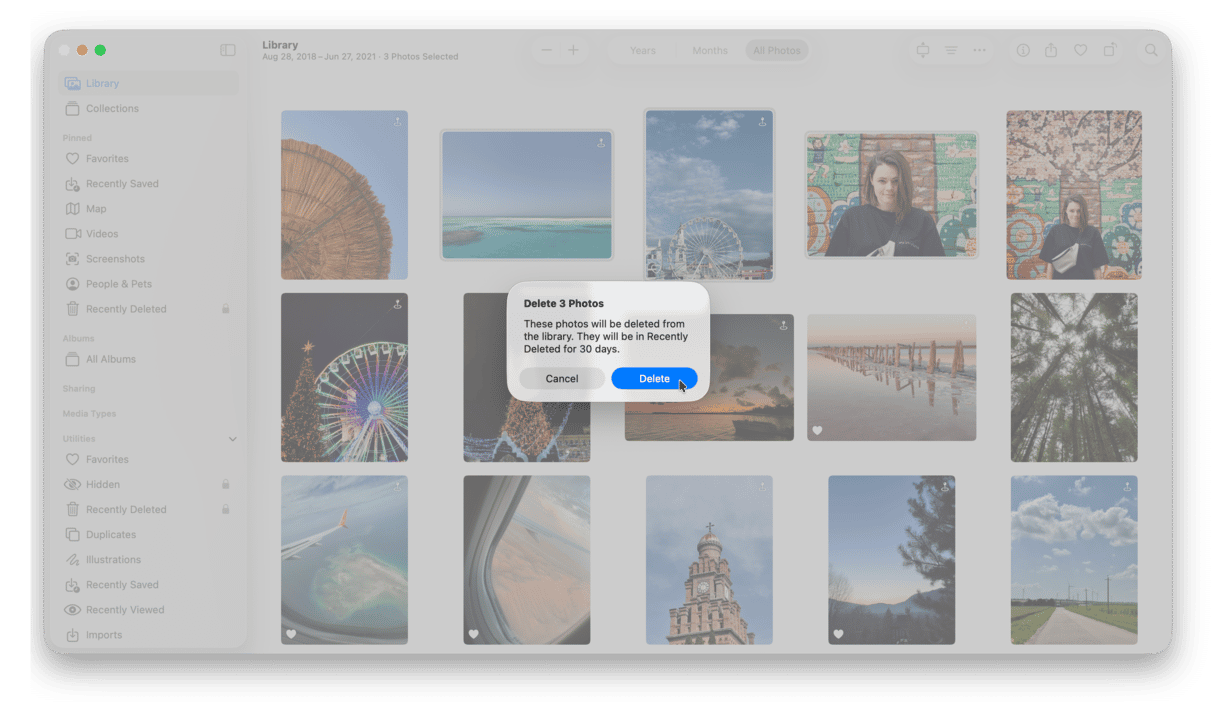
If you don’t want any of your photos in iCloud anymore, unsync them completely. To do so, you’ll need to to System Settings > Apple Account > iCloud > Photos and disable the Sync this Mac option. This will untie all the pictures you had in the Photos library from iCloud. You can tie them back by reversing what you’ve just done and checking the app back in.
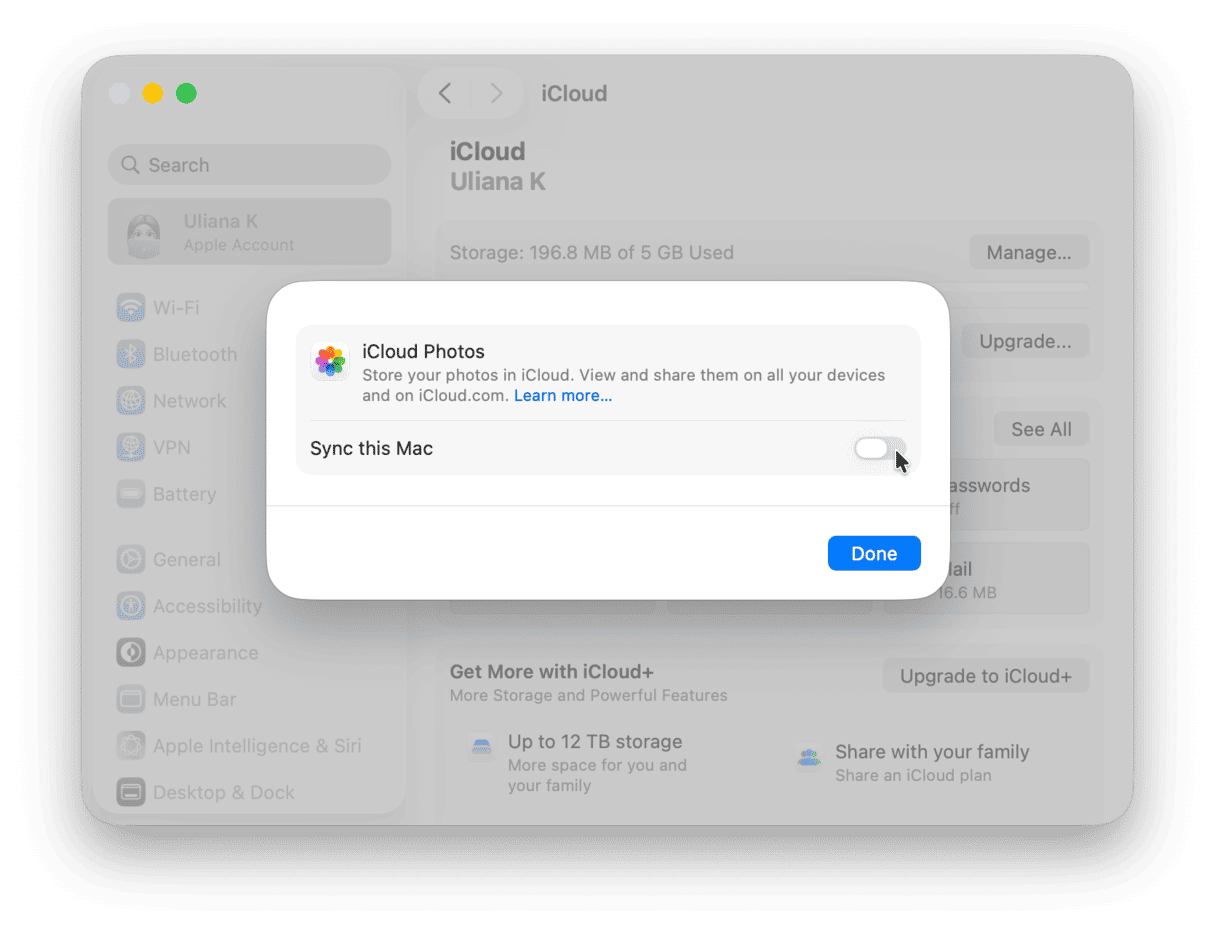
How to delete movies from iCloud Drive
The process is pretty similar to deleting photos from cloud storage — you can remove them directly from the iCloud Drive folder or delete the movies on icloud.com.
You can also delete movies you’ve already watched by using built-in storage optimizing tools:
- Go to the Apple menu and select System Settings.
- Next, go to General > Storage.
- You’ll see Recommendations; click Optimize.
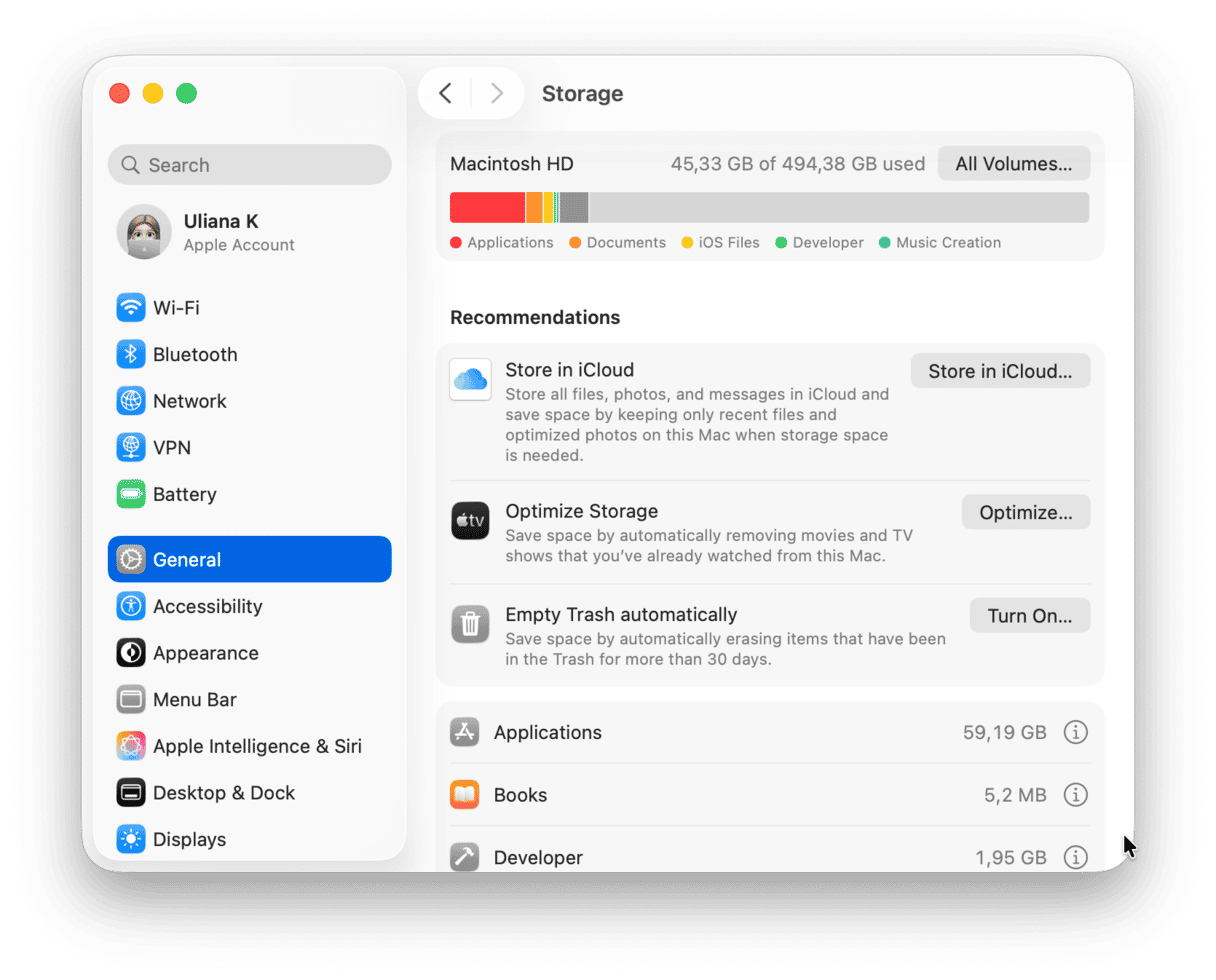
How to delete apps from iCloud
This part is a little tricky. It actually depends on what you mean by “deleting apps.” In case what you need is to simply get rid of apps that are syncing against your will, so to speak, you can just open System Settings > Apple Account > iCloud, click See All, and disable those apps.
Also, click Drive > Apps syncing to iCloud Drive and check if you have not missed any apps.
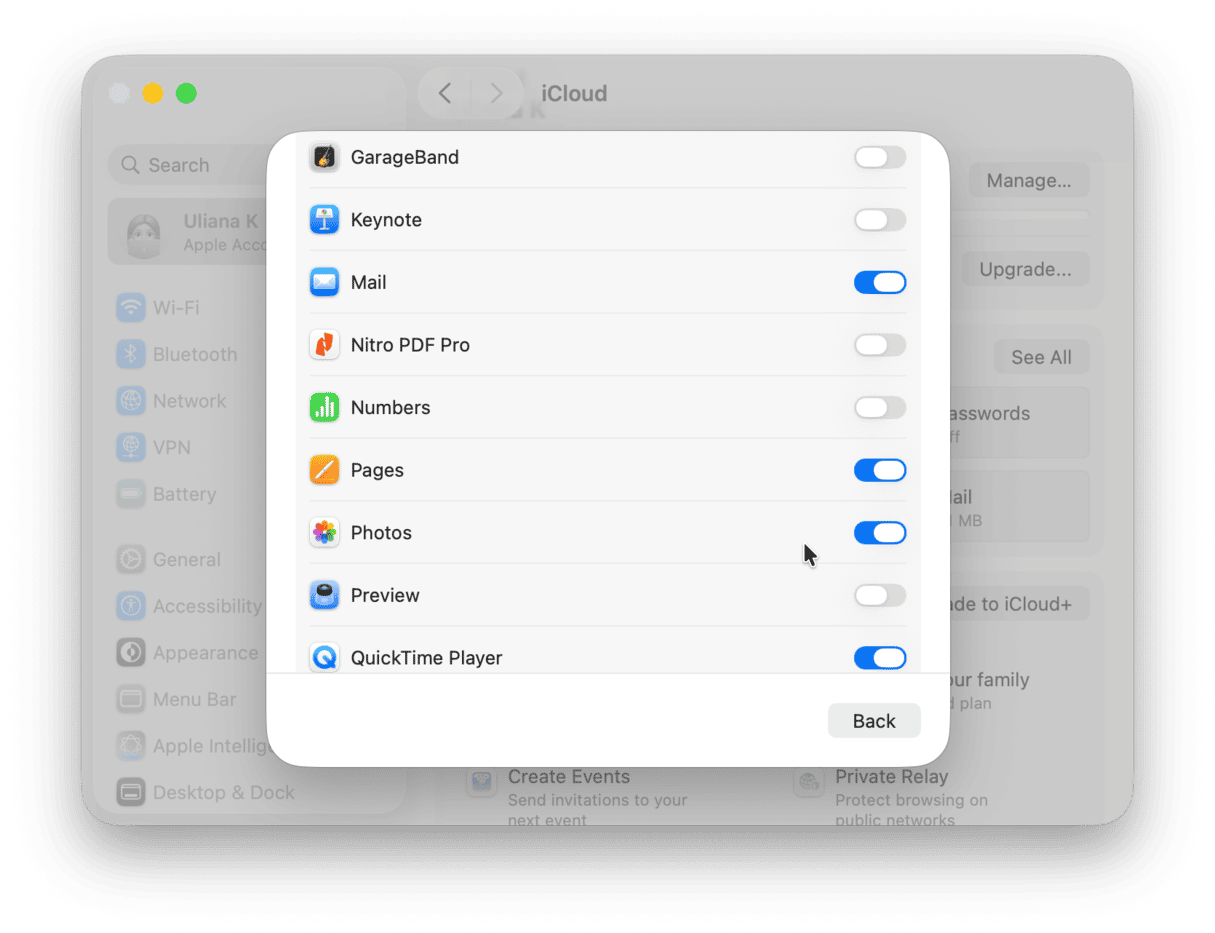
In case you have an installer of the app (just the icon, not the contents of it) in the iCloud folder, you can remove it as any other file by dragging it to the Trash or Command (⌘)-Delete-ing it.
Tips for iPhone/iPad
Now that you've cleared iCloud on Mac, let's proceed with iPhone and iPad. The steps are similar to those for Mac, but there are a few more things you can do. First, go to Settings > Apple Account > iCloud and then check what you can do here:
- Look at Recommended for you — it includes tips on freeing up space.
- Tap See All next to Saved to iCloud and disable those apps that you do not want to sync to iCloud. Apps listed here automatically back up to iCloud, so do not leave unneeded stuff enabled.
Now you know the options, and whatever you decide works best for you — freeing up iCloud storage or simply buying more — the rule of thumb is to keep your iPhone and Mac free from clutter.
Frequently asked questions
What is iCloud storage?
iCloud storage is a service from Apple that lets you store your files, photos, and app data in the cloud. It syncs your data across all your Apple devices, so you can access your information from anywhere.
What happens when my iCloud storage is full?
If your iCloud storage gets full, your devices will no longer be backed up and your apps will not sync. Your photos, files, and videos will also not be uploaded to the cloud until you reclaim some space or upgrade your storage plan.
Why is my iCloud storage still full after deleting files?
It may be that iCloud is still in sync or stores some residual data. Check if you've emptied the Recently Deleted folders (otherwise, files will be stored there for 30 days) and give it some time to complete the unsyncing process — it may take up around several hours.
Do shared albums count against my iCloud storage?
These albums count against the storage of the person who created them, so they count against your storage only if this person is you.
Is it worth upgrading iCloud storage or should I just clean up?
It all depends on your needs and budget. It is better to start with cleaning up, and if there's still not enough space, consider upgrading. The upgrade may seem pretty cheap, but the payment is monthly.
Can I use alternative cloud storage instead of iCloud for large files?
Yes! The cheapest alternative is an external drive. Although you have to invest in buying one, it pays off over time since you do not have to pay for the iCloud storage plan monthly. If you do not want to save your files to external drive, you can use Dropbox, OneDrive, or Google Drive, but these are also paid-for options.
What are the biggest space hogs in iCloud?
Usually, these are backups, photos, videos, and app data, so delete any unneeded items included into these categories whenever you need to free up some iCloud space. Also, clean these up regularly to prevent iCloud storage from filling up in the future.






